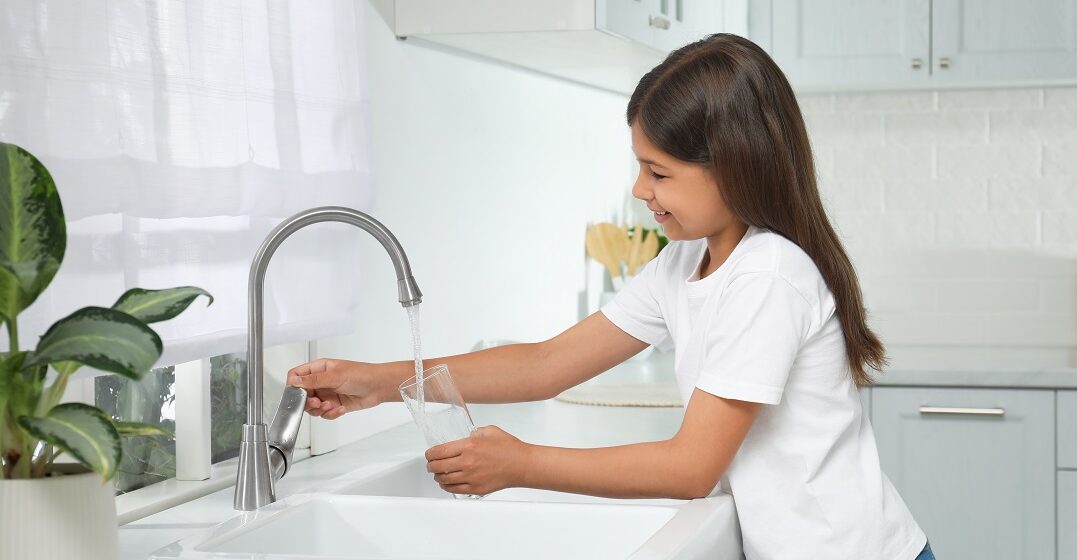Published on April 24, 2023

Can you drink French tap water?

France is famous across the world not just for its gastronomy and its wine, but also for some of its water brands. With bottled water from such iconic names as Evian and Perrier, you may be wondering about the quality of tap water in France. So, can you drink French tap water without any risk to your health?
The answer is generally “yes.” In the vast majority of places, it is perfectly safe to drink French tap water. But that’s not the whole story. Let’s weigh the pros and cons of French tap water and take a look at some of the major branded waters available in France. Once you’ve decided where your preference lies, you may also want to learn some useful vocabulary to help you discuss different types of water and order drinks in a restaurant.
Many French people may prefer bottled alternatives, but you can drink the tap water served in France without any risk to your health. According to recent data from the World Health Organisation, drinking tap water is safe in 99% of all cities in France. Still, with a growing focus on environmental factors and health and safety, French people often prefer to filter their water or to buy it bottled. It’s considered by many to be healthier and better-tasting, especially in parts of France where the water is judged to be hard.
Age is one factor to consider when opting for or against tap water. Ideally, it’s better to avoid giving newborns and infants tap water. Many parents choose to instead let them drink only bottled water clearly labeled as suitable for infants. On the other hand, many toddlers and older children drink plenty of tap water and face no adverse outcomes.
For a country so famous for its wine, you may be impressed by just how many water brands are available in French supermarkets, They can be divided into two groups: brands of eau plate (still water), like Evian, Volvic or Vittel, and brands of eau gazeuse (carbonated or sparkling water), like the world-famous Perrier, as well as Badoit, Saint-Yorre and La Salvetat.
Some brands are linked to specific regions of France. Evian is synonymous with the French Alps, while Volvic evokes ties to the extinct volcanoes of central France. Other brands attempt to set themselves apart by promoting their specific composition and health benefits. One example is Taillefine (a brand name that can be translated as “slim waist”) which allegedly helps its consumers lose weight thanks to its high level of minerals. Indeed, different water brands have unique concentrations of minerals. If you need to limit your absorption of some, make sure to check the labels carefully or ask your doctor or healthcare professional for advice.
Even as a beginner in French, the words about types of water belong to the basic vocabulary around food you’ll find useful to know. In the following table, we’ve recapped the most common ones for you:
| French | English |
| eau avec bulles* | water with bubbles |
| eau en bouteille | bottled water |
| eau calcaire | hard water/lime water |
| eau chaude | hot water |
| eau courante | running water |
| eau froide | cold water |
| eau gazeuse | sparkling water/carbonated water |
| eau minérale | mineral water |
| eau pétillante | fizzy water |
| eau plate | still water |
| eau du robinet | tap water |
| eau sans bulles* | water without bubbles |
| eau de source | spring water |
| eau tiède | lukewarm water |
As you may have guessed, eau avec bulles and eau sans bulles are common images used to refer to gaz and still water. It is typically the kind of phrases parents may use with their children.
When taking your order in a restaurant, your waiter may ask you what you want to drink with one of the following questions:
| French | English |
| Et à boire ? | And to drink? |
| Et comme boisson ? | And for drinks? |
| Vous désirez boire quelque chose ? | Would you like to drink something? |
| Vous voulez boire quelque chose ? | Do you want to drink something? |
You can simply reply by mentioning the drink you’d like, followed by s’il vous plaît (please). In the case of water, you may also want to specify if you would like to have de l’eau plate (still water) or de l’eau gazeuse (carbonated water).
Unless you specify otherwise, your waiter will bring you a bottle of water, which can be pricey, especially in touristy destinations. For a cheaper alternative, and if you’re happy drinking tap water in France, you should ask for une carafe d’eau (a pitcher of water).
A word of warning for American readers: water is normally served without ice, especially as it tends to be served cold anyway. If you like your water extra-cold, you may want to say, De l’eau plate avec des glaçons, s’il vous plaît (“Still water with ice, please”).
To conclude, you can safely drink French tap water and still have the choice between that and various water brands, both still and sparkling, each with their composition and health benefits. This may come at a price. If you’re in a restaurant, for instance, bottled water is usually more expensive than tap water.